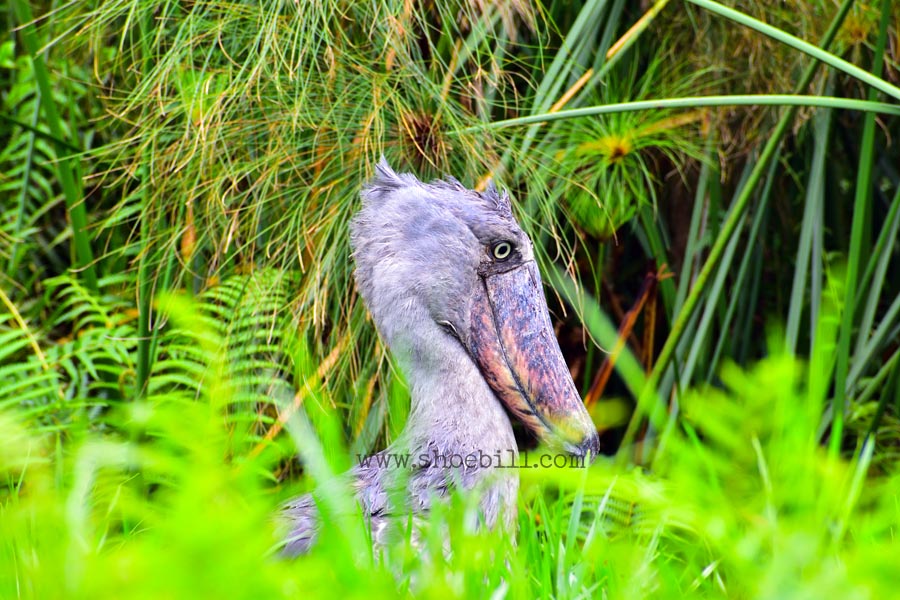The Shoebill

Shoebill: The Prehistoric-Looking Bird
Taxonomic History
The Shoebill (Balaeniceps rex) is a large, stork-like bird belonging to the order Pelecaniformes and family Balaenicipitidae. Described scientifically in 1850 by John Gould, its name derives from the distinct shape of its massive bill, resembling a shoe. It was historically classified with storks (Ciconiidae) or herons (Ardeidae), but genetic studies revealed its closer relationship to pelicans.
Evolution
Shoebills have a lineage dating back millions of years, with ancestors that likely shared traits with storks, herons, and pelicans. Their unique adaptations—particularly their massive bill and stealthy hunting behavior—have allowed them to thrive in specialized wetland environments. Their prehistoric appearance has earned them comparisons to dinosaurs and pterosaurs.
Distribution and Habitat
Shoebills are endemic to tropical East Africa, where they inhabit swamps, marshes, and wetlands. Their range includes:
- South Sudan
- Uganda
- Rwanda
- Tanzania
- Democratic Republic of Congo (DRC)
They are most commonly associated with papyrus swamps and areas with slow-moving or stagnant freshwater that supports their primary prey, lungfish.
Species
The Shoebill is monotypic, meaning it is the only species in its genus and family. No subspecies are recognized.
Conservation Status
The Shoebill is classified as Vulnerable on the IUCN Red List, with an estimated population of 5,000–8,000 individuals. Its primary threats include:
- Habitat Loss: Wetlands are being drained for agriculture and urban development.
- Human Disturbance: Increasing human presence and ecotourism disrupt their nesting and feeding behaviors.
- Hunting and Pet Trade: Shoebills are targeted for their striking appearance and sold illegally as exotic pets.
- Climate Change: Rising temperatures and changing water levels threaten their wetland habitats.
Conservation efforts focus on habitat preservation, anti-poaching measures, and awareness campaigns to protect this unique bird.
Interesting Facts About the Shoebill
- Unique Hunting Style: Shoebills are patient hunters, standing motionless for hours before striking prey with their powerful bill.
- Massive Bill: The shoebill’s bill can be up to 24 cm (9.4 in) long, with sharp edges used to decapitate fish and other prey.
- Diet: They primarily eat lungfish but also consume other fish, amphibians, baby crocodiles, turtles, and occasionally small mammals.
- Silent but Fierce: While usually quiet, shoebills produce a loud, bill-clapping sound during courtship or to communicate, resembling a machine gun.
- Prehistoric Appearance: Their large size, slow movements, and dinosaur-like features give them a primeval look, often compared to pterosaurs.
- Impressive Wingspan: Shoebills have a wingspan of 2.3–2.6 meters (7.5–8.5 feet), aiding in gliding over wetlands.
- Solitary Nature: They are solitary birds, only coming together for breeding.
Breeding and Nesting
Shoebills typically nest during the dry season when water levels are lower. They construct large nests on floating vegetation or mud, often 1-3 meters wide. Females lay 1-3 eggs, but only the strongest chick usually survives due to siblicide (a form of natural selection).
Cultural Significance
Shoebills are revered and feared in some African cultures, often seen as omens or mystical creatures. Their unique appearance has made them popular in wildlife photography and ecotourism, further contributing to their cultural importance.
Conservation Initiatives
- Protected Areas: Wetlands in regions like the Sudd (South Sudan) and Mabamba Bay (Uganda) are designated as conservation sites.
- Community Engagement: Local communities are involved in ecotourism and habitat protection efforts to promote coexistence.
- Monitoring Programs: Researchers use tracking devices to study shoebill movement and behavior, aiding in targeted conservation strategies.
Role in the Ecosystem
Shoebills are apex predators in their wetland habitats, playing a critical role in regulating fish and amphibian populations. Their presence is also an indicator of healthy wetland ecosystems.
The Shoebill is a fascinating and enigmatic bird, capturing the imagination of birdwatchers and conservationists alike. Its prehistoric features, unique behaviors, and ecological significance underscore the importance of preserving this remarkable species and its wetland habitats for future generations.

